Mobilizing for the Climate and Biodiversity Emergency on an Urbanizing Planet
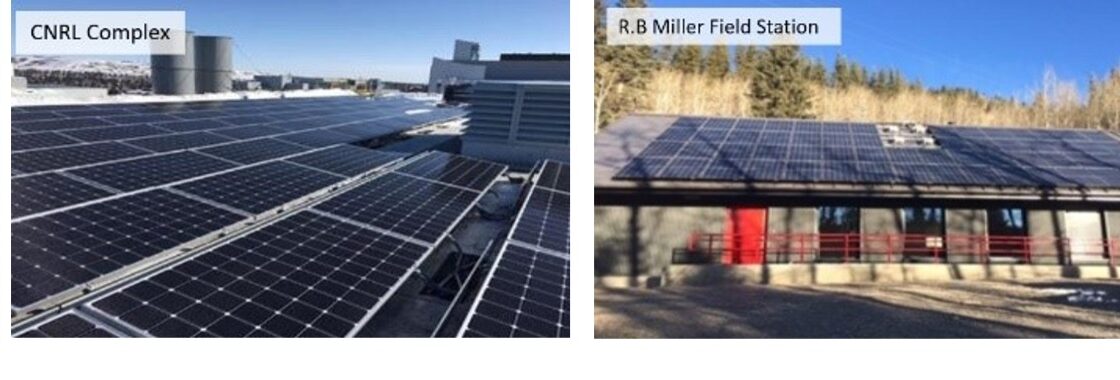
“…urbanization will change the surface of our planet and the biodiversity that is an essential part of it. Over the next 40 years, Earth will undergo the largest and fastest period of urban growth in human history. By 2050, an additional area the size of South Africa is projected to become urban. By then 6.3 billion people will live in towns and cities, an increase of 2.8 billion from 2010, a more than doubling of the world’s urban population in just forty years…”
An Urbanizing Planet, Stockholm Resilience Centre, Secretariat of the Convention on Biological Diversity, SCBD, 2013
The central findings of the UN Global Status Report 2018 confirm that “buildings play a dominant role in the clean energy transition. Building construction and operations accounted for 36% of global final energy use and nearly 40% of energy-related carbon dioxide (CO2) emissions in 2017.” Embodied carbon of our city buildings will be responsible for almost half of total new construction emissions between now and 2050; this does not include the embodied carbon for the retrofit of our existing buildings and cities. When expanded to include other city infrastructure, cities are the critical leverage point for energy system decarbonization. A global dataset of CO₂ emissions for 343 cities compiled by Global Carbon Project scientists in collaboration with international organizations highlights cities as “… hotspots of the global carbon cycle, with considerable fossil fuel CO₂ emissions from electricity consumption, ground transportation, residential and commercial buildings” (see Figure 1 below).
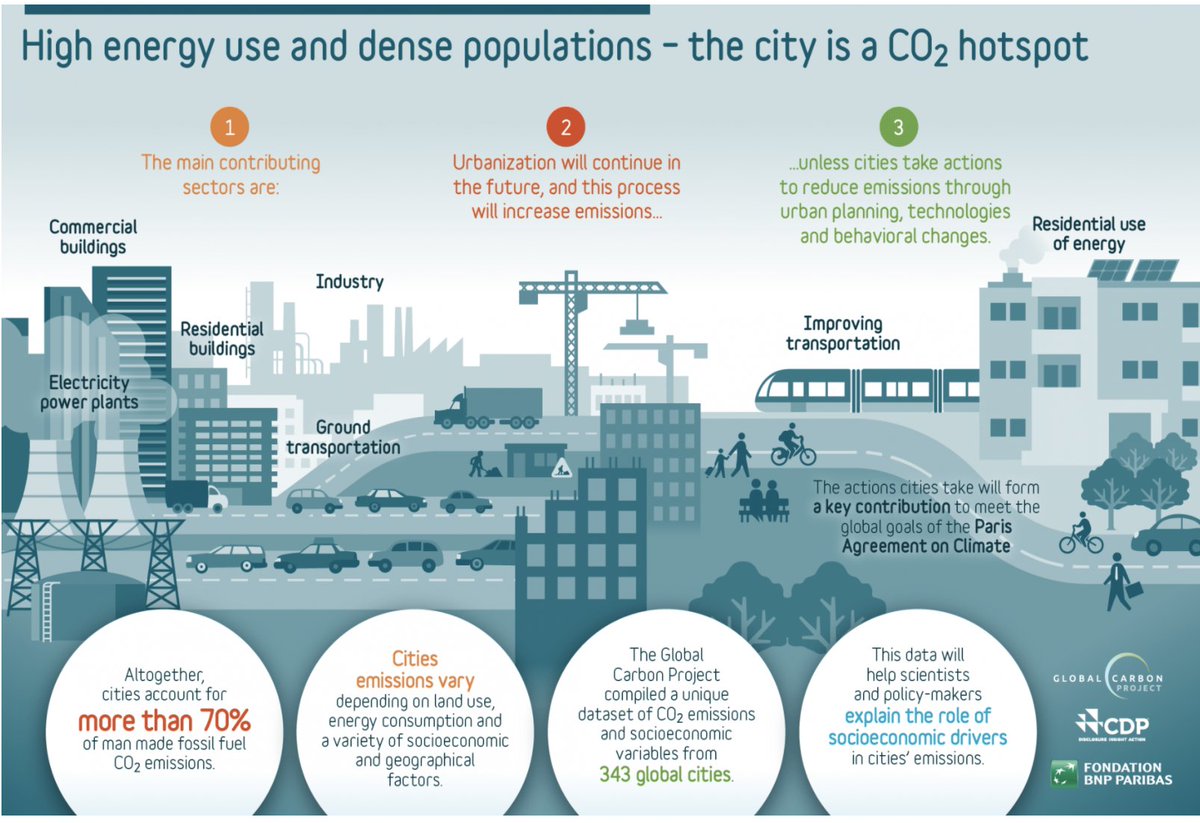
In addition to rapidly transitioning current buildings and cities to reach a low carbon and climate resilience future, we must concurrently accommodate city growth from an estimated 68% of a nine billion plus world population that is projected to live in urban areas by 2050, while meeting zero carbon targets – all within the finite carrying capacity of our planetary systems. For perspective, studies have estimated this growth to be the equivalent of constructing an entire New York City every month for the next 40 years. Energy flows through every step of this undertaking, from material for buildings to ongoing annual operations.
Buildings and cities lie at the core of the climate challenge and offer vast opportunities to accelerate the great transition to a low-carbon future. In December 2020, the Government of Canada released its strengthened climate plan, which builds upon the Pan-Canadian Framework on Clean Growth and Climate Change and sets a course to a 31% reduction in Canada’s greenhouse gas (GHG) emissions by 2030. According to the Progress Towards Canada’s Greenhouse Gas Emissions Reduction Target, Canada’s economic sectors are projected to achieve 283 megatonnes of reductions relative to 2015 projections by 2030 and the Buildings sector is expected to provide 44 megatonnes of emissions reduction representing approximately 15% of total reductions (see Figure 2 below).
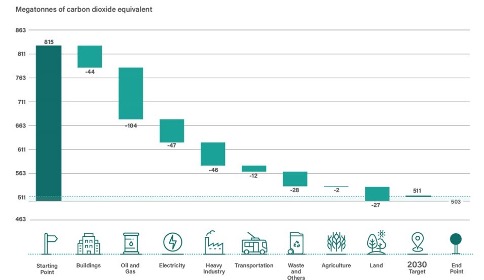
The University of Calgary’s Climate Action Ambition
The University of Calgary is committed to helping achieve Canada’s Nationally Determined Contributions to the Paris Agreement. The University released its first Climate Action Plan (CAP) in 2010, which was subsequently renewed in 2019 including updated targets to align with international and federal targets. The 2019 CAP sets a course for carbon neutrality by 2050, starting with a goal of 50 percent GHG emission reductions by 2030. As of 2020, UCalgary has realized a 33% absolute reduction in annual GHG emissions, representing over 75,000 tonnes annually – despite substantial growth in built area and population on campus. To put this into perspective, this is equivalent to removing approximately 16,000 passenger vehicles from the road.
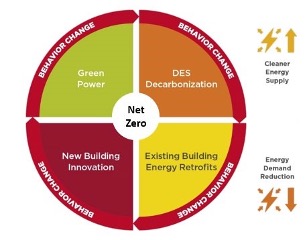
99 percent of UCalgary’s Scope 1 and 2 greenhouse gas emissions are from the built environment; thus the 2019 Climate Action Plan includes four primary areas of focus around the built environment as outlined in Figure 3. By 2030, the University will need a further 75,000 tonnes reduction to meet the 2030 target including 10,000 tonnes through new building innovation, 33,000 tonnes through green power and 30,000 tonnes from existing buildings’ energy retrofits, outlined in Figure 4.
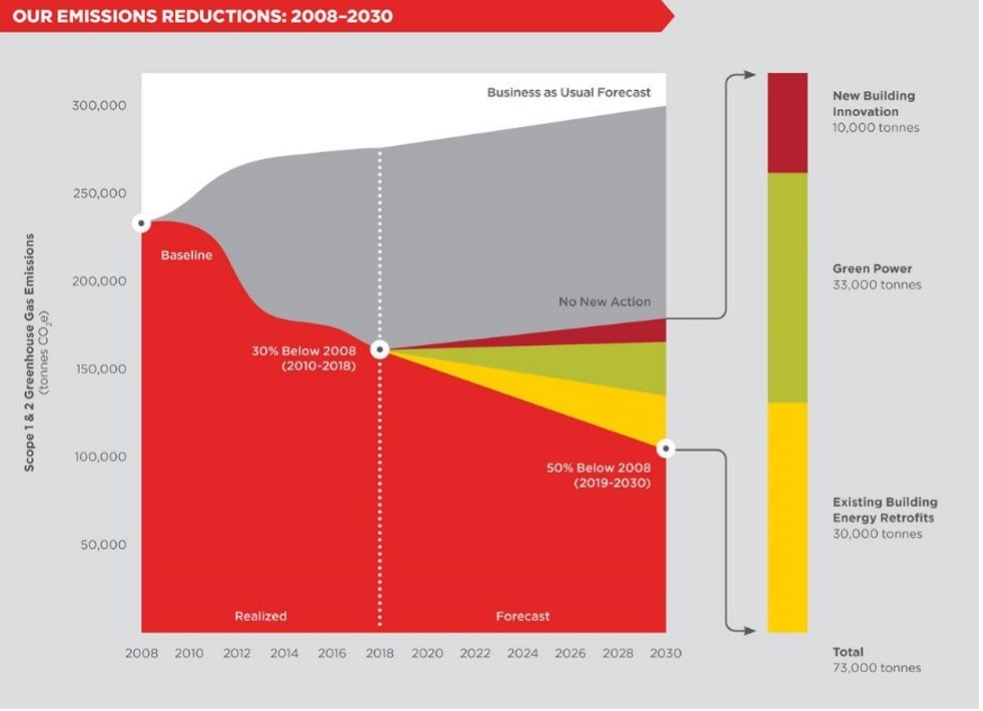
The following is a summary of some of the current approaches under each of the University’s CAP four focus areas:
Focus 1: New Building Innovation
UCalgary has certified 14 LEED projects including two Platinum buildings, which have helped mitigate the GHG growth associated with campus growth. However, reaching carbon neutrality will require even greater ambition, thus new projects will strive for net-zero carbon certification. Further, where viable, preference will be given to existing building renewal over new construction.
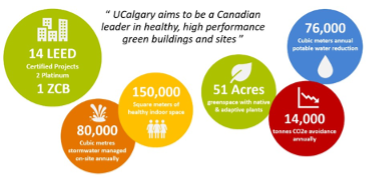
As of 2020, the University has three projects registered under the Canada Green Building Council’s Zero Carbon Building Standard. The first is the 32,000 square meter MacKimmie Complex, which includes a 15-storey deep building renewal. This $290M project reduces the Energy Use Intensity (EUI) from over 550 before construction to a EUI of approximately 70 post-construction. This represents a 75% reduction from the median energy use for this building type in Canada and meets the project goal to be one of the most energy-efficient buildings in Canada. In 2020, the Canada Green Building Council awarded the MacKimmie Complex Zero Carbon Building Design Certification and their national Green Building Excellence – Zero Carbon Award. In addition to MacKimmie, Mathison Hall, now under construction, is pursuing zero-carbon building certification, and a third project is in the early design stage. As a deep building renewal, MacKimmie dramatically reduced embodied carbon through retaining the concrete superstructure of the former library tower and annual energy use is on track to achieve close to a 90% reduction from preconstruction operations.
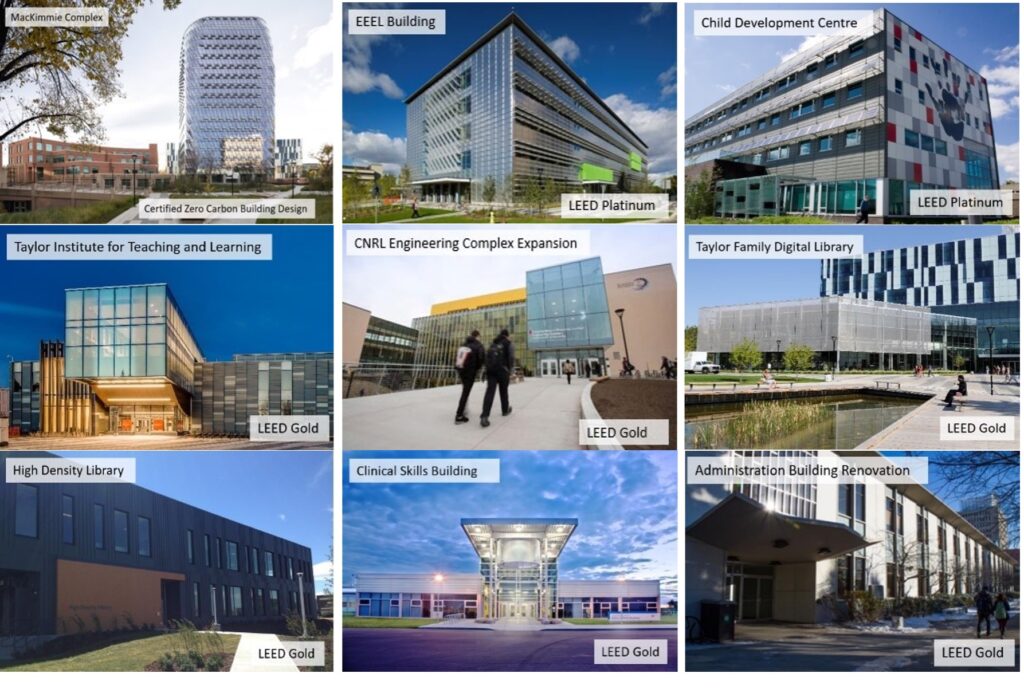
Focus 2: Existing Building Energy Efficiency
With a portfolio of over 150 buildings and over 10.5M square feet of buildings, the energy retrofit transition of our building portfolio is no small feat, particularly with many energy-intensive laboratory buildings and no decant facilities. Further, reducing the energy and carbon intensity of existing buildings is not simply a matter of new technologies, it also requires an organizational cultural shift across the teams responsible for the design and delivery of new projects as well as the large building operations and maintenance teams. This necessitated the development of a comprehensive strategy for existing buildings.
Our response was developing an Energy Demand Management Plan (EDMP) to help build an energy-centric operational culture and enable diverse departments to understand their role in advancing energy efficiency within the Climate Action Plan. Developed in alignment with the ISO 50001 Energy Management Standard, the EDMP includes implementing an advanced Energy Management Information System (EMIS) to leverage smart technology and advanced energy analytics to optimize ongoing performance. The EMIS incorporates building a culture of enhanced energy literacy and leadership through training, communications and engagement programs, among other priorities.

Completing in 2023, the current Utility Reduction Program is investing over $35M in broad-scale basic energy retrofits and is on track to provide 30,000 tonnes of annual GHG emissions reductions and close to $3M in annual cost avoidance. Additionally, the EMIS is deploying advanced Fault Detection Diagnostics software across our most energy-intensive buildings, providing new visibility and capabilities. Last year, in water alone, this data contributed to over $1.5M in utility cost avoidance.
Focus 3: Decarbonization of the District Energy System
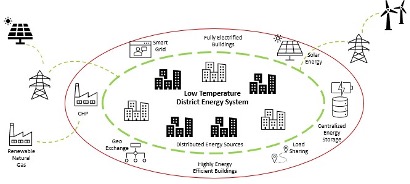
The 2019 CAP identifies a high-level concept for the decarbonization of the main campus District Energy System (DES). The current DES includes a high-temperature hot water distribution system supported by a 13 MW natural gas-fired co-generation system. The co-generation system produces much lower carbon electricity on campus (in comparison to electricity procured from the high GHG intensity Alberta electrical grid) and waste heat from the co-generation turbine is captured and utilized for building heating and domestic hot water use. As the Alberta electricity grid phases out coal-fired electricity generation and increases renewable energy sources, the emissions reductions benefits of the co-generation system will diminish. The 2019 CAP proposes a pathway to transition the DES to a low-temperature thermal system that is compatible with low/no GHG energy sources (see Figure 8), which also supports recovering waste heat from facilities such as data centres for use in facilities that need heat. In 2021 we will undertake a second stage feasibility study to advance this project.
Focus 4: Green Energy
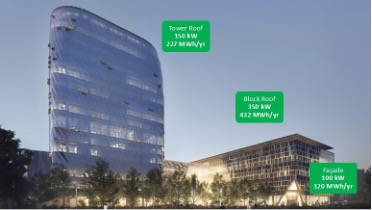
The last focus area is green energy. The CAP proposes a combination of on-site and off-site renewable energy. To date, UCalgary has completed four on-site projects including the Child Development Centre (44 kW), the Canadian Natural Resources Limited (CNRL) Engineering Complex (60 kW), R.B. Miller Field Station (17.1 kW) (also designed to Passive Haus Standard) and the Spo’pi House (7 kW), which serves as a renewable energy reach lab. Current projects in planning include a combination of building integrated photovoltaic (PV) and roof-mounted PV installations that will generate an estimated 1,020 MWh annually and a projected GHG avoidance of approximately 580 tCO2e/year.

Preparing the Next Generation of Climate Action Leaders
In 2017 we started with a question: How can we better prepare and rapidly grow the number of graduates to amplify progress on the climate crisis and the United Nations Sustainable Development Goals (SDGs)? Our answer was the Campus as a Learning Lab (CLL) program. CLL is designed to build core competencies for leadership in sustainability through providing experiential learning opportunities on real-world questions with real-world data. Launched in 2018, the 2019-20 academic year saw over 800 students participating in diverse projects linked to the SDGs and to sustainability practices on campus. CLL spans co-curricular programming where students engage in voluntary projects such as designing and installing a solar energy project in the campus community garden, to course-based projects such as the life-cycle assessment of different building material systems in zero carbon buildings, to master’s level research such including can we use green bonds to finance major capital sustainability projects.
Experiential learning in sustainability is essential for helping students translate class-based knowledge into applied practice. It also enables students to understand how they can incorporate sustainability into their professional endeavours after they graduate. We are scaling CLL through partnerships with diverse academic programs across campus and will include external partnerships starting in 2021. CLL is increasing both the number and preparedness of graduates to bring their talent to diverse professions to accelerate action on the climate crisis and the SDGs.
Challenges and Future Considerations
The University of Calgary has made strong progress to date and while we are proud of the journey so far, we recognize that much difficult work remains to be done. While technical challenges often come first to mind, my observation is that the most difficult challenge – and most effective leverage point – is changing mindsets and organizational culture. It takes a diverse and interdisciplinary team to realize large projects and culture change. With the right mindset, strong leadership, and a collaborative team pulling in the same direction, we can achieve transformative outcomes.
Another key challenge is project financing. The work required to transition the existing building stock and energy systems to enable a low-carbon future is costly and while paybacks on basic retrofits are strong, deep retrofits and energy-system changes are more costly and require large amounts of upfront capital that is difficult to access. Further, public sector organizations lack the financial levers available to for-profit private sector organizations and are facing increasingly difficult financial positions due to ongoing budget cuts.
The next steps in advancing our climate ambition will be to expand from science-based targets for Scope 1 and 2 emissions to science-based targets for Scope 3 emissions. Unlike Scope 1 and 2 emissions, which can be managed with robust data quality, Scope 3 emissions are challenging to quantify with a strong level of data confidence. Our CLL program provides us with a unique opportunity to leverage the strengths of our Haskayne School of Business and our Schulich School of Engineering to begin mapping our value chain and explore new tools to more effectively gather and manage Scope 3 data. As we look to renew our CAP, three new focus areas are anticipated: Scope 3 emissions, a strong focus on adaptation to climate change impacts with an emphasis on nature-based solutions in landscape design, and revitalizing biodiversity health to help restore ecosystem services and nature’s capacity to regulate climate.
Closing Thoughts
In the lead-up to the 2021 COP26 climate conference, there is an expanded uptake in climate action commitments. For example, the Race to Zero is now the largest ever alliance committed to reaching net-zero carbon by 2050 with signatories (as of 2020) representing close to 25% of global GHG emissions and 50% GDP. Action on these net-zero carbon commitments must be informed by science-based targets in concert and systems thinking to inform systems-level change. The Science Based Targets initiative (SDTi) published a paper outlining a conceptual foundation for science-based net-zero target setting with the aim to bring clarity and consistency to target setting that aligns with the scientific literature. It can be argued that failure to align with science-based targets while promoting net-zero carbon goals is the most damaging form of climate crises denial.
Despite ongoing commitments to climate action, Canada’s national GHG emissions trend over the past two decades remains largely unchanged and will require a much different scale and pace of ambition. Drawing on the ideas of Seth Klein and his recently released book “A Good War: Mobilizing Canada for the Climate Emergency”, there remains a harrowing gap between what science tell us we must do and what our society and economy are currently doing – winning slowly on climate is the same as losing. How then do we close the gap in the context of the built environment? Mobilizing Canada for the climate and biodiversity emergency in the context of an urbanizing planet requires all of us to reach much further to shift our scale of thinking from incremental efficiencies to transformative scales of change and to activate the necessary resources to close the gap between the scientific facts and our actions. We have a decade, sufficient time if indeed we act from an emergency mindset.












